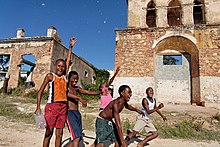
Back Afrokubaner German Αφροκουβανοί Greek Afrocubano Spanish Afro-kubatar Basque Afro-Cubains French אפרו-קובנים HE Afrika-Kuba ID Afro-cubanere NB Afro-cubanos Portuguese Categorie:Afro-cubanezi Romanian
 Black Cuban people | |
| Total population | |
|---|---|
(9.26% of the Cuban Population)[1] (2012) | |
| Regions with significant populations | |
| Havana, Eastern Cuba | |
| Languages | |
| Spanish, Lucumí, Habla Congo, English, Portuguese, French, Haitian Creole, Cuban Sign Language | |
| Religion | |
| Afro-Cuban religions Abakuá, Arará religion, Cuban Vodú, Palo, Santería Popular religions Predominantly Roman Catholic, Islam, Muslim minorities of Protestant | |
| Related ethnic groups | |
| Yoruba people, Arará, Fang people, Bubi people, Cape Verdean Cuban, Ganga-Longoba, Haitian Cuban, Africans, Afro-Dominicans, Afro–Puerto Ricans |
Afro-Cubans (Spanish: Afrocubano) or Black Cubans are Cubans of full or partial sub-Saharan African ancestry. The term Afro-Cuban can also refer to historical or cultural elements in Cuba associated with this community, and the combining of native African and other cultural elements found in Cuban society, such as race, religion, music, language, the arts and class culture.[2]
- ^ "Archived copy" (PDF). www.one.cu. Archived from the original (PDF) on 3 June 2014. Retrieved 11 January 2022.
{{cite web}}: CS1 maint: archived copy as title (link) - ^ The American Heritage Dictionary of the English Language, Fourth Edition. Houghton Mifflin Company. Random House Unabridged Dictionary, Random House, Inc. 2006.